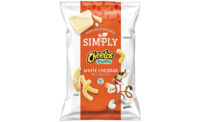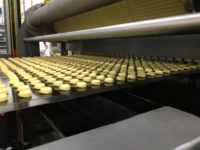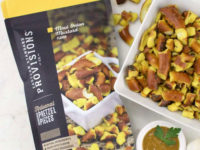When we consider the cookie market today, it’s a far cry from the ones that your grandma used to serve: They come in all shapes and sizes, and some can even be considered a “better for you” snack now, too. The market is changing, and consumers are now able to find any and all varieties that they desire.
Overview | Bread | Tortillas | Sweet Goods | Snack Cakes | Pizza | Desserts | Cookies | Buns & Rolls | Bars | Breakfast Products
Market data
Data from IRI, Chicago from the 52 weeks ending March 24, 2019 point to a cookie category increase of 2.6 percent to $8.8 billion. Mondelēz International continues to lead the category, with a 4.1 percent increase in sales to $3.3 billion. After private label, which saw a 3.9 percent increase in sales to $1.4 billion, Mondelēz takes the next four brand slots with flagship Nabisco brands:
- Oreo, up 4.0 percent to $721.1 million
- Chips Ahoy, up 0.4 percent to $640.5 million
- BelVita, up 6.1 percent to $371.3 million
- Oreo Double Stuf, up 15.0 percent to $307.6 million
McKee Foods Corp. brought in $619 million in sales with an overall increase of 1.4 percent. Its Little Debbie cookies remained relatively flat, down 0.7 percent to $295.7 million, while sales of Little Debbie Nutty Bars grew 4.6 percent to $198.7 million.
Tate’s Bake Shop showed the largest increase in sales in the category, with a 30.4 percent jump, bringing in $82.5 million for the year.
“Thin” cookies also performed well for the year, with Nabisco Oreo Thins up 10.5 percent to $175.2 million. Oreo has also found continued success with its seasonal LTO offerings, which included flavors like Peppermint Bark and Birthday Cake in 2018.
Looking back
“On-the-go snacking has transitioned from a trend to a lifestyle,” says Kevin Joseph, vice president of marketing, THINSTERS, Farfield, NJ. “Snacks and desserts are small, portable and better-for-you.” The cookie category continues to cater to dessert lovers looking for flavor and healthier attributes, he says.
THINSTERS offers a thinner cookie, and it rebranded itself in January 2019 from “Mrs. Thinsters” to simply THINSTERS. Its holiday flavors, released in October 2018, included Limited Edition Dark Chocolate Coconut and White Chocolate Peppermint varieties. Joseph notes that the cookies are made without artificial flavors or colors, no high fructose corn syrup, and no preservatives.
Following the better-for-you trend, protein cookies have been finding an audience. Lenny & Larry’s—now a $107 million retail brand, per IRI—released a White Chocolaty Raspberry flavor in October 2018, an Apple Pie flavor in July 2018. The cookies are in a larger, one cookie per serving format. Diversifying its offerings, Lenny & Larry’s released a Complete Crunchy Cookies bite-sized line in September 2018. All of the company’s cookies are made with plant protein; they’re vegan, contain no artificial sweeteners or sugar alcohols, and are made without GMO ingredients, soy or dairy.
Frank Flider, oils consultant, QUALISOY, St. Louis, says that a cookie’s ingredients should never limit its potential. “After all, it’s all about flavor and enjoyment, the best quality and optimum cost. Oils and shortenings have long had historic functionality. For cookies, the right shortening is indistinguishable to the customer—it doesn’t leave the cookie too dry or too soggy; it imparts the right texture and flavor characteristics and performs as expected in the finished product.”
Flider recommends high-oleic soybean shortenings, which are sustainably grown and 100 percent domestically produced. They also deliver extended shelf life, increased stability and a neutral flavor profile, and the ingredients are readily available.
“Choosing the right fat or oil, like high-oleic soybean shortening, can banish the worry of producing a product that doesn’t meet the baker’s—or customer’s—standards, and ultimately streamline production,” adds Flider.
“Bigger” cookies—similar to Lenny & Larry’s—seem to be in demand, says Jim Fontaine, bakery specialist, Reiser, Canton, MA—and not exclusively in better-for-you formats. “I see a lot of companies making ‘pizza cookies’ or ‘monster cookies’ with lots of large inclusions.”
Fontaine also notes that gluten-free cookies are in great demand. In May 2018, Kakookies—another large-format cookie brand—went through a packaging change and reformulated its cookie line, which is now gluten-free. Flavors include Cashew Blondie, Almond Cranberry, Dark Chocolate Cranberry, and Boundary Waters Blueberry.
The cookie brittle category is getting in on the trend too: Brooklyn Bites released its gluten-free and vegan cookie brittle in October 2018. The free-from brittle is made without gluten, dairy or soy, and the line has six different flavors from which to choose: Coco Crispy Rice, Cinnamon Coffee Cake, Nutty Chocolate Sea Salt, Chocolate Lovers Delight, White Chocolate Brownie and Crunchy Creamy Pretzel.
Sheila G’s Brownie Brittle, our 2018 “Bakery of the Year,” created the cookie brittle category when it hit the market in 2011. Now the company carries several varieties, including gluten-free and organic options.
“Although the overall gluten-free market toward baked goods is small, as a total percent, gluten-free cookies will be the larger, sustainable percent of sales for that category,” says Fontaine. He cautions that finding the right combination of gluten-free ingredients to produce a good recipe that consumers will like is key to any product’s success. “It takes many bake tests to refine your formula, but finding the correct flavor, mouthfeel and aroma for a gluten-free product starts with the correct ingredient balance.”
Fontaine notes that bakers have developed a wide range of gluten-free cookie formulas that range from soupy to sticky dough textures. That can make the doughs difficult to manage on the line. “Finding the correct machine to handle and produce gluten-free products will allow companies to expand their market share, keeping up with this trend. Streamlining production by incorporating equipment to handle mixing, dividing/forming, panning and packaging will ensure that the baker can produce a uniform, gluten-free product to meet the quality that major chain buyers want to see.”
Looking forward
“We anticipate the current trends to continue, while also seeing lighter cookies take the spotlight. Light dessert options are replacing heavier, fuller desserts,” says Joseph. “For instance, THINSTERS Cake Thins serve as a coffee cake or a breakfast dessert replacement, with flavors like Blueberry and Cinnamon that pair perfectly with morning coffee without the heaviness of a traditional desert.”
Cookies like the PARTNERS Mia Dolci Crispy Shortbread Cookies, released in January 2019, exemplify this trend, as they are billed as a “lighter and crispier indulgence than traditional shortbread.”
Gluten-free and “better-for-you” will continue to trend forward. “Although gluten-free products command a premium price, streamlining will also help them control their product costs and allow them to increase margin and be more competitive when negotiating with retail outlets,” explains Fontaine. “We have a staff of bakery specialists located across the country. Our bakery specialists understand the product and the machine, and are able to match the proper solution to the producer’s opportunities. We have been in the bakery world for many years, and can apply a library of knowledge with cutting-edge engineering to help our customers.”
Whether they be small or large, “better for you” or indulgent, cookies will never go out of style, and the industry will continue to grow throughout the next year.
Overview | Bread | Tortillas | Sweet Goods | Snack Cakes | Pizza | Desserts | Cookies | Buns & Rolls | Bars | Breakfast Products










